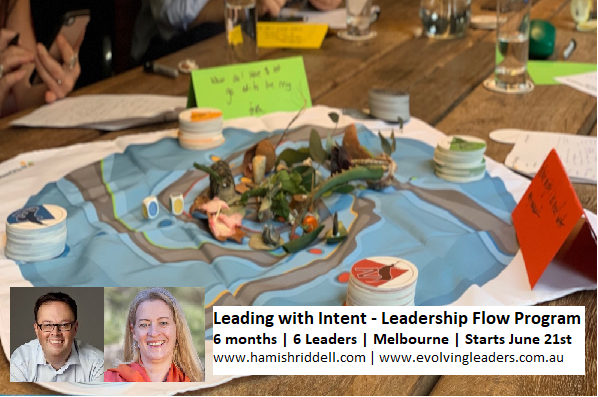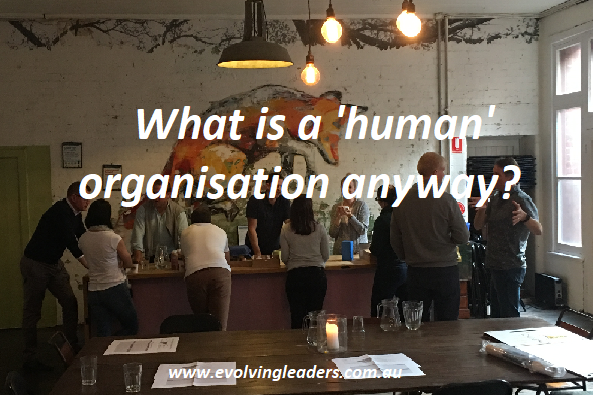
A unique development opportunity. 6 months | 6 Leaders | Melbourne | Starts June 21st 2019
Do you feel like you are out of flow?
Do you sense there is a better version of your leadership just out of reach?
Are you wrestling with questions that don’t have easy answers?
Are you caught in the whirlwind of doing (not being)?
Would you benefit from a having some external support to navigate long over-due changes?
Do you need a regular space to spend time working on being a better version of you?
If this is you then ”Leading with Intent” is for you. The focus of Leading with Intent is on taking your story – your ‘you’ – to the heart of your leadership.
We invite you to join this different and powerful development experience. This exclusive program has been designed for six like- minded leaders and includes:
– five half day development sessions over six months utilising The Flow Game
– two individual development sessions (prior to program start and at the conclusion)
– your own peer support learning group; and
-ongoing guidance from your flow game hosts during the program .
Full program details
This post includes our vision for the ‘human’ teams and organisations of the future that we need to be designing and creating right now to respond and flourish in a rapidly changing world. We call these ‘human organisations’. The post includes the characteristics of a human organisation to help you do a ‘mini-audit’ on the health of your own team/organisation.
“A culture in which everyone could overcome their own internal barriers to change and use errors and vulnerabilities as prime opportunities for personal and company growth.”
– Robert Kegan in Everyone Culture: Becoming a deliberately developmental organisation
Almost anyone who has worked in an organisation has experienced at least some of the aspects of disconnection that have become commonplace in workplaces everywhere. Too often businesses seem to lose sight of the fact that they are, at their core, the sum of the humans of which they are composed. There is ample evidence that this needs to change if businesses are serious about flourishing in the complexity of today’s world.
What is a human organisation?
Human organisations are ‘well’ organisations that are on a deliberate and focussed developmental and cultural evolutionary pathway towards full spectrum consciousness.
There are two central threads that are the woven foundations of a human organisation:
Connection – Connection to self, connection to each other, connection to purpose and vision and connection to the people they serve; and
Accountability – Accepting and embracing accountability to self, each other, the reality (role, team, goal, project, organisation) and holding self and others to account.
Human organisations exude a healthy vibrant culture in which people are inspired to bring out the best possible versions of themselves. In human organisations, people perform at their best without being coaxed or bribed to do so. Instead of reverting to immature behaviours of blame and justification when they come to work, they see themselves as well-rounded adults whose task is to make a meaningful contribution and to help others do likewise.
The result is far more significant contributions from many more people, and a lot less wasted time and emotional energy. The result is greater success in traditional business measures (e.g. profitability and customer satisfaction) as well as improved wellbeing, increased engagement and sustainable human potential.
What are the characteristics of a human organisation?
Some of the characteristics you’re likely to see in a human organisation include:
- Customers feel listened to and their needs are meet at a level beyond their expectations because employees deeply care and feel cared for and supported by the organisation.
- Leadership is less about position than it is about mindset and behaviour. Everyone in the organisation is capable of being recognised as a leader through the way they behave and the choices they make, through supporting others and taking personal responsibility rather than resorting to blame, justification and denial. No one is seen as a leader unless they demonstrate leadership in this way, regardless of their position or title.
- Purpose driven: there is a clear and central ‘why’ that is harvested and activated by the people for the people. It is a grounded source of energy and focus that clarifies, inspires and informs decisions, action and behaviour.
- People are motivated through feeling valued. There is an alignment between what matters to them, the work they do and the workplace culture.
- Connection – real, human connection – with courage and compassion are at the heart of everything that is done within the organisation and for those it serves. Get Connected
- People feel empowered to make choices. High levels of confidence, personal awareness, and accountability exist throughout the organisation.
- People are held to account – They know what is expected of them in their roles and how they ‘show up’ and there are efficient and effective practices and leadership capability to manage this effectively.
- People take responsibility for their own development in a culture of learning and growing.
- People feel a sense of belonging. It feels safe for people to fully show up as who they are and make a meaningful contribution with their unique skills, strengths and preferences. The workplace and its practices are diverse and inclusive and team members experience high levels of psychological safety which results in higher levels of team performance.
- People are highly engaged, feeling a greater sense of connection with their own sense of purpose, with their colleagues and as co-contributors to the organisation’s success in terms of profitability, wellbeing and benefit to the community.
- Internal divisions and turf wars are minimised. Shared values and purpose provide the framework for conversations, decision-making and behaviour. Strategy, culture, purpose and wellbeing are aligned.
- People listen to one another.
- Innovation and creativity are well understood, practised and regarded as ways the organisation can ‘separate itself from the crowd’.
- Reflective practices are woven into the fabric of the organisation. This may include specific mindful moments in meetings, the way performance conversations are had, allocated time and expectations for people to build reflective practice into their weekly rhythm.
- Time and space to think and learn are valued. The space is created to allow people to get to know each other and to reflect on the learning from projects and other experiences they encounter in their day to day. This becomes a part of the daily, weekly, monthly and annual rhythm.
You may like to pause and reflect for a moment here:
- What is the current state of health of your team or organisation?
- What are the strengths that you can build on?
- What areas do you need to bring greater focus to?
- What is one step you can take this week to get started?
Where it starts
Ignoring the need to make your organisation more human is to turn a blind eye to what we know requires a new level of response. It is no longer an option to stand still. The teams and organisations that will thrive and attract the best people are the ones that make the courageous and bold step to begin this developmental, leadership and cultural evolution journey.
However, it needs to be recognised that human organisations are not created overnight. They need to be imagined and designed ‘by the people, for the people’, then given the guidance, investment, nourishment and support they need to grow.
The shift towards a human organisation begins with bringing new awareness to the leadership team about the possibilities of becoming such an organisation. We help leaders to make the connection between the cycle of pain, dysfunction, cultural entropy and poor performance that they may be experiencing in their teams and organisations and bring focus to the antidote for this – which is intentionally growing and creating ‘human organisations’.
Initial steps often involve understanding the current stage of cultural maturity and the cultural evolution required for the team /organisation to evolve to a level of cultural maturity that will enable the business aspirations, measurement of the existing organisational culture, beginning the conversation around organisational purpose and vision and igniting the learning journey for leaders and their teams.
A key part of the learning here is about helping leaders to better understand the visible and invisible forces driving, engagement, wellbeing and performance in the organisational eco-system. A great basis for this conversation and to help build understanding of the organisation as a whole interconnected system is Ken Wilbur’s four quadrant model. It helps to bring a ‘whole of system’ focus and is a great basis for surfacing what is currently helping and what is hindering the organisation’s progress, ahead of then designing a roadmap for cultural and leadership evolution.
If all this sounds just too complex and difficult right now, may I offer one powerful snippet of wisdom:
Connection and Accountability are the golden threads that are woven throughout a human organisation.
In every moment – thought, action, word, decision – we have a choice. We can choose to move towards disconnection or we can choose to move toward connection. In that very action we are being accountable to ourselves, each other and our workplaces.
I choose to grow connection.
What do you choose?
In my next post, I will explore the personal leadership that is required to grow a human team/organisation.
The previous post outlined why reflective practice is a leadership super power and surfaced some of the richness that reflection brings. This post explores three of the barriers to creating space and time to reflect and provides you with a structure to get started.
My previous blog post explored why reflective practice is a leadership super power and surfaced some of the benefits and insights that reflection helps us with. In this post I want to explore three of the internal barriers to getting started and provide you with a framework and some great questions to inspire you to do it anyway!
The reality is that reflective practice is something most people, including most leaders, have never done. We live in a society, and certainly in workplaces, in which ‘doing’ and ‘tasks’ are what are valued and creating space to reflect and learn is far from the reality.
Three main barriers to reflective practice
There are three main barriers that get in the way of us creating space and therefore creating the environment to reflect:
- We don’t schedule it/plan for it/turn up for it
- We don’t value it – ‘Why would I bother doing that?’
- We think that what it might show up for us feels too daunting and scary – so it is safer/better not to do it at all
Let’s explore these:
- We don’t schedule it/plan for it/turn up for it
In my earlier ‘Five keys to creating conscious change and restoring wellbeing’ post, I introduced the 5S leadership self-care model. The first S in this model talks about making ‘space’ – carving out space – which means scheduling it into your calendar and creating the conditions to support that schedule (such as finding the best environment for you to be able to bring your full focus to the intended activity: reflection).
Even if you do schedule time for reflective practice, it can be all too easily get ‘bumped’ for something more ‘important’ that appears on your to-do list. The biggest tip I can offer here is schedule it and show up fully for yourself – no excuses. Treat it as you would a meeting with your boss or a client.
2. We don’t value it – ‘Why would I bother doing that?
If we don’t understand the benefits of a new practice, we won’t value it. My hope is that if this is new for you, that some of what has been explored in the previous post will help you to at least feel tempted to give it a go. Perhaps ask around and connect with another leader who you know does use reflective practice and ask them personally about why they do it and how they go about doing it.
3. We think that what it might show up for us feels too daunting and scary – so it is safer/better not to do it at all
In a crazy-busy life, we often have a backlog of things we need to process and make sense of. If this is the case for you, then carving out space can feel quite daunting and even scary. Why?
Because sometimes we keep ourselves so busy because that means we don’t have to look at and face up to what is really happening and true for us. If we don’t look towards this stuff and keep running from it, then we don’t need to have that honest conversation with ourselves or another, and we won’t need to make a choice or decision that may mean change. Right?
This can be a sensible and even worthy strategy in the short term, depending on life circumstances. However, in the medium to longer term it will catch up with us. If we keep ‘shying away’ from what we know is true for us and pretending that everything is okay – if we don’t start to face up to what is really true for us – we can begin to compromise the very core of our being. That doesn’t serve you, the situation or anybody else.
Can you relate to any of the above? What is standing in the way of you reflecting?
Getting started with reflective practice
Here is a framework that might help to get you started:
- Schedule it
- Show up for it
- Structure it
Option 1
- Recall and review: identify a recent situation/event/conversation/feeling/trigger that you want to explore. Capture the key points you recall, replay the conversation in your head and/or begin the process of a written journal.
- What are the key learnings?
- What did you notice?
- What did you say?
- How did you feel?
- What were you most proud of?
- What were you not so proud of?
- What do you now understand about yourself?
- What do you now understand about the situation?
- Set direction with what you now understand about yourself. The situation, the other person, etc. What will you do differently next time? What is your intention and course of action from here?
Option 2
Thinking about the past week or month, ask yourself the following questions:
- What am I most proud of?
- When have I felt triggered by a particular situation or event?
- What made me feel that way?
- What can I observe/learn about myself in this situation?
- What action do I need to take from here (if any?)
Leaders who thrive are those who care enough about themselves and those they lead to do this – to look in their own backyard and do their own self-work.
Still feeling too tough? You don’t have to go it alone. A good way to start might be to get yourself a leadership coach who can ‘hold the space’ for you so you can begin a gentle journey inwards.
I also recommend the host of resources referred to in my ‘Five keys to creating conscious change and restoring wellbeing’ post. Perhaps you simply feel ready to grab a notebook and get started?
To reiterate the closing words in my last post:
One of the greatest leadership/life challenges is knowing who we are and what matters to us at our core AND not letting the busyness of life and a multitude of external distractions pull us away from that.
One thing is guaranteed: unless you deliberately and regularly carve out space to engage in reflective practice and take a balcony perspective, life will pull you off course from your centre – from who you are and what matters to you.
If you do build a reflective practice into your rhythm in life, the conversations might be tougher but the outcomes will also be richer.
The choice is yours. What do you choose?
The previous post involved a personal story that highlighted the shifts that can happen when we make space to reflect. This post builds on that example and explores other benefits of reflection, why the reflective practice is a leadership super power and how to build it as a practice into your own way of being.
Leaders whom I work with in a coaching capacity often comment that during our time together they experience a sense of space and an absence of judgement. They appreciate the chance to slow down and reflect. It’s from this place that clarity and insight become available resulting in better decisions, choices and outcomes.
To be truly conscious, awake and aware of both your inner landscape and the outer terrain of work and life requires a paradigm shift for leaders about the importance of something I believe is a leadership ‘super- power’: reflective practice.
I wish I could find a better term for it than ‘reflective practice’ – I know it sounds more like something that nuns would prescribe as a punishment at boarding school than a leadership super power. (Perhaps you can suggest a better name?)
Nevertheless, it’s the sentiment rather than the name that is important.
Reflective practice needs to become something that happens not just in a formal setting such as coaching. Rather, it needs to extend to become an integrated part of your daily, weekly, monthly and yearly modus operandi as a leader.
What is reflective practice?
Joseph A Raelin, in his article‘”I don’t have time to think” versus the art of reflective practice’,defines reflection as:
‘the practice of periodically stepping back to ponder the meaning of what has recently transpired to ourselves and to others in our immediate environment. It illuminates what the self and others have experienced, providing a basis for future action.’
How does reflective practice help?
As highlighted in the personal story in my previous post, often when we are in the middle of a situation, particularly a stressful one, we cannot maintain the perspective we need to be able to see the situation holistically. It’s only when we create the space and time to reflect that we are able to ‘step off the dance floor’ and get a broader ‘balcony’ perspective of what’s going on. The outcome? Insight, insight, insight. Insight about how you showed up effectively (or not so effectively). A greater capacity to see the perspective of others. The opportunity to identify what ‘triggers’ you and to explore why. The chance to bring light to a problem that may have felt impossible to solve, creating new options and a clear pathway forward.
Why does this matter? Because the consequence of not making time to reflect is quite possibly collateral damage to projects and relationships; damage that is inevitable when we operate completely in action and reaction.
Perhaps you can recall a specific example of where this may have happened to you? Or the opposite: can you think of a time when you did create the time and space to reflect on a challenge and experienced a positive outcome as a result?
What are the benefits?
Some of the benefits of reflective practice are:
- Seeing below the surface to reveal what really is happening. Reflective practice can make the invisible visible. For instance, it can bring to the surface a personal value that might be important to yourself or others and that might explain why a conversation/ outcome/ situation went in a particular direction.
- Restoring wellbeing:
- A simple shift from ‘doing’ constantly to taking space out to ‘be’ helps our nervous system to restore balance (Blog: Mastering thinking and doing AND feeling and being).
- A dose each of compassion and self-compassion will go a long way towards resolving something that doesn’t feel so good so that you can let it move through you (Blog: Are you being a good friend to yourself?)
- Reflective practice opens the opportunity for gratitude. Research has shown that the practice of gratitude has many positive benefits (https://positivepsychologyprogram.com/benefits-gratitude-research-questions/ )
- Connecting the dots. With reflective practice we may begin to see connections between behaviours, actions or situations that previously didn’t appear to be connected. For example, when I learned that one of the personal values of a colleague was ‘control’, I started to understand some of the ways she was behaving in our collaboration. I had previously I felt that her behaviour was out of character and not really serving our partnership. This provided an opportunity to open up the conversation. Connecting the dots can also happen within our own internal landscape. To share a personal example: understanding that the reason I was overprotective of my daughter stemmed from an experience in my past in which I didn’t feel safe.
- Insight, insight, insight. Reflective practice ignites learning about ourselves and the people and world around us. This is essential if we want to live and lead consciously and learn and grow.
- Strengthening connections: with ourselves – what matters to us at our core – and in our relationships with other people.
- Shifting you out of a reactive mindset to allow constructive ‘above the line’ responses. Reflective practice will make you less likely to react and add fuel to what might already be a difficult situation. You are more likely to ‘discharge the heat’ and approach the next conversation in a more open and constructive manner. ( If this concept is new to you – check out this 3 minute u-tube – it’s a concept well worth knowing)
One of the greatest leadership/life challenges is knowing who we are and what matters to us at our core while also not letting the busyness of life and a multitude of external distractions pull us away from that.
One thing is guaranteed: unless you deliberately and regularly carve out space to engage in reflective practice and take a balcony perspective, life will pull you off course from your centre – from who you are and what matters to you.
On the other hand, if you do build reflective practice into the rhythm of your life, the conversations might be tougher but the outcomes will be so much richer.
In my next post, I outline one of the big road blocks that many people experience in getting started with reflection and provide some tips and great questions to get you started.




